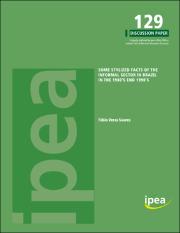Please use this identifier to cite or link to this item:
https://repositorio.ipea.gov.br/handle/11058/5004Full metadata record
| DC Field | Value | Language |
|---|---|---|
| dc.contributor.author | Soares, Fábio Veras | - |
| dc.coverage.spatial | Brasil | pt_BR |
| dc.coverage.temporal | 1981-1999 | pt_BR |
| dc.date.accessioned | 2015-10-29T22:23:32Z | - |
| dc.date.available | 2015-10-29T22:23:32Z | - |
| dc.date.issued | 2015-01 | - |
| dc.identifier.uri | http://repositorio.ipea.gov.br/handle/11058/5004 | - |
| dc.description.abstract | Dois fatos caracterizaram a evolução do setor informal no Brasil nas últimas duas décadas: o aumento na proporção de empregados sem registro em carteira e a redução no diferencial de salários entre trabalhadores registrados (com carteira) e sem registro (sem carteira). Neste trabalho, foi brevemente revisada a literatura sobre o setor informal em países em desenvolvimento e documentados tanto o aumento da informalidade quanto a redução do diferencial de salários. Adicionalmente, investigouse quais fatores foram responsáveis pela redução no diferencial de salários e como tal redução contribuiu para a diminuição da desigualdade salarial entre 1981 e 1999. Entre os resultados encontrados, destacam-se: i) a coincidência entre esses dois fenômenos e as reformas pró-mercado do início dos anos 1990; ii) a redução do diferencial de salários formal/informal como o segundo fator mais importante para a redução da desigualdade de salários, após educação. Por que e como isso ocorreu ainda são questões abertas ao debate. Tais aspectos serão analisados em dois Textos para Discussão que serão publicados futuramente. Neste trabalho, tanto o impacto da abertura comercial sobre o setor informal como os efeitos da crescente indexação dos salários do setor informal ao salário mínimo serão estudados. | pt_BR |
| dc.language.iso | en-US | pt_BR |
| dc.publisher | Instituto de Pesquisa Econômica Aplicada (Ipea) | pt_BR |
| dc.title | Some Stylized Facts of the Informal Sector in Brazil in the 1980’s end 1990’s | pt_BR |
| dc.title.alternative | Discussion Paper 129 : Some Stylized Facts of the Informal Sector in Brazil in the 1980’s end 1990’s | pt_BR |
| dc.title.alternative | A evolução do setor informal brasileiro no período 1981-1990 | pt_BR |
| dc.type | Discussion Paper | pt_BR |
| dc.rights.holder | Instituto de Pesquisa Econômica Aplicada (Ipea) | pt_BR |
| dc.source.urlsource | http://www.ipea.gov.br | pt_BR |
| dc.location.country | BR | pt_BR |
| dc.description.physical | 44 p. : il. | pt_BR |
| dc.rights.license | Reproduction of this text and the data it contains is allowed as long as the source is cited. Reproductions for commercial purposes are prohibited. | pt_BR |
| dc.subject.keyword | Setor informal de emprego | pt_BR |
| dc.subject.keyword | Registro de trabalho | pt_BR |
| dc.subject.keyword | Diferencial de salários | pt_BR |
| dc.subject.keyword | Desigualdade salarial | pt_BR |
| dc.relation.references | http://repositorio.ipea.gov.br/handle/11058/1993 | pt_BR |
| ipea.description.objective | Revisar a literatura sobre o setor informal em países em desenvolvimento; documentar tanto o aumento da informalidade quanto a redução do diferencial de salários; investigar quais fatores foram responsáveis pela redução no diferencial de salários, e como tal redução contribuiu para a diminuição da desigualdade salarial entre 1981 e 1999. | pt_BR |
| ipea.description.additionalinformation | Série monográfica: Texto para Discussão ; 1020 | pt_BR |
| ipea.description.additionalinformation | Possui referências bibliográficas e apêndice | pt_BR |
| ipea.description.additionalinformation | Série: Originally published by Ipea in May 2004 as number 1020 of the series Texto para Discussão. | pt_BR |
| ipea.access.type | Acesso Aberto | pt_BR |
| ipea.rights.type | Licença Comum | pt_BR |
| ipea.englishdescription.abstract | Two facts have characterized the evolution of the informal sector in Brazil during the last two decades: the increase in the proportion of non-registered workers and the diminishing wage gap between non-registered and registered workers. In this paper, we briefly review the literature on informal sector in developing countries and document both the increase of the informal sector and the fall in the wage gap in Brazil. Besides, we investigate which factors were responsible for the fall in the wage gap and how this reduction has contributed to reduce wage inequality between 1981 and 1999. Among our findings, we would highlight: i) the coincidence between these two movements and the market-oriented reforms of the early 1990’s; ii) that the fall in the formal/informal wage gap has substantially contributed to the decrease in wage inequality. After education, the fall in the wage premium due to the possession of a work-card was the main responsible for bringing down wage inequality. Why and how it happened is an open debate. We will tackle this issue on two forthcoming papers were we investigate the role of the trade liberalization (Soares, 2004a) and the effects of the increasing indexation of informal sector wages to the minimum wage (Soares, 2004b) | pt_BR |
| ipea.researchfields | N/A | pt_BR |
| ipea.classification | Emprego. Trabalho | pt_BR |
| Appears in Collections: | Emprego. Trabalho: Livros | |
Files in This Item:
| File | Description | Size | Format | |
|---|---|---|---|---|
| DiscussionPaper_129.pdf | 591.24 kB | Adobe PDF |  View/Open |
Items in DSpace are protected by copyright, with all rights reserved, unless otherwise indicated.

